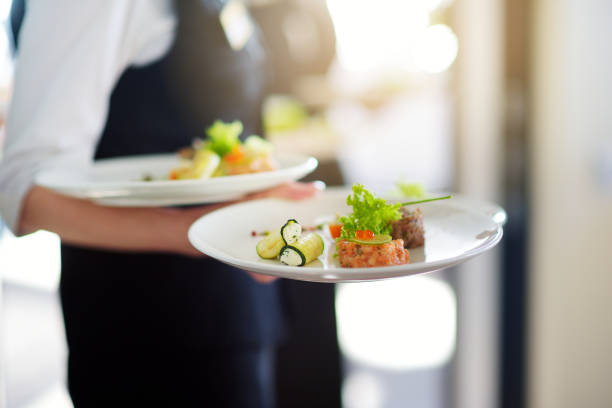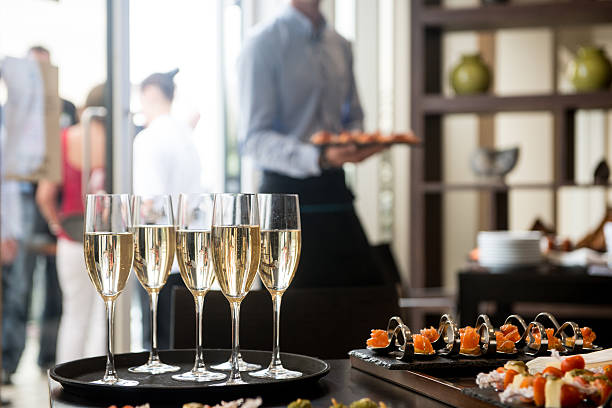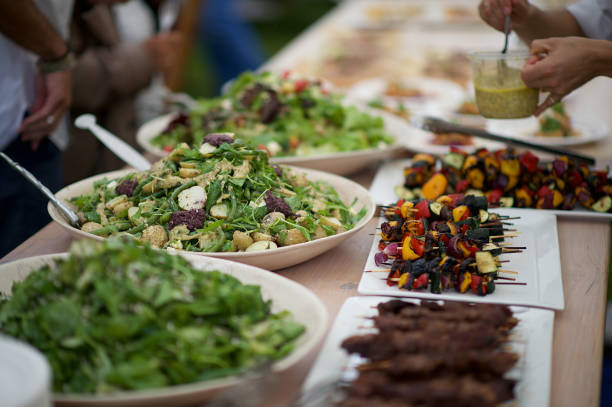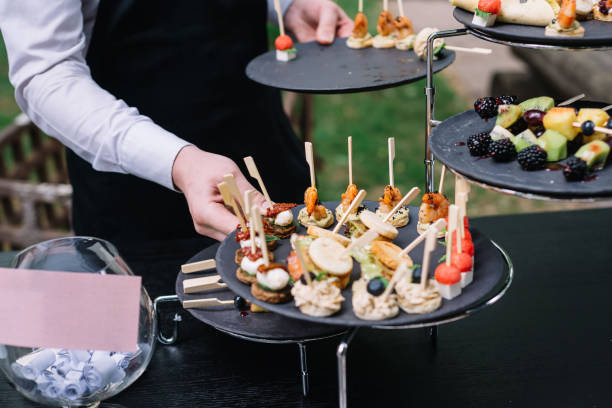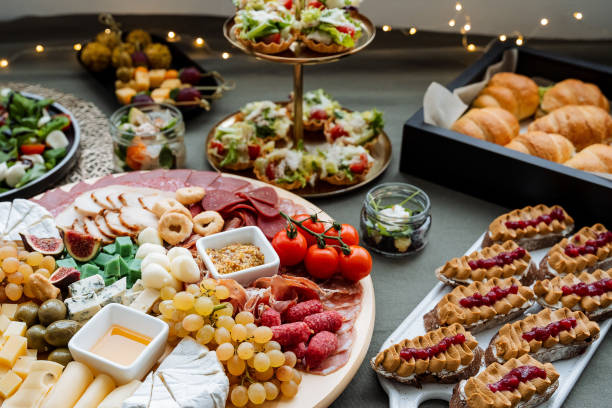
Organizing office catering is a pivotal part of hosting successful corporate events. Whether it’s a large-scale conference, a team-building luncheon, or a simple office celebration, thoughtful planning ensures the event leaves a lasting impression on attendees. This guide will walk you through essential tips to streamline the process and elevate your corporate catering game.
Discover the Perfect Wedding Catering Washington DC for Your Event
- Is the event formal or casual?
- Will it be an all-day affair or just a short gathering?
- Are there specific themes to incorporate into the menu or presentation?
Aligning your catering plan with the purpose of your event helps create a cohesive experience for attendees.
Planning Your Event with a Catering Company Washington DC Experts Trust
Accurate numbers are essential when planning office catering. Overestimating could lead to unnecessary waste, while underestimating might leave guests unsatisfied.
- Estimate Guest Count: Include employees, clients, and any third-party participants attending.
- Age groups
- Cultural backgrounds
- Professional hierarchy (e.g., executives may expect more sophisticated options)
Tailoring food options to your audience ensures everyone feels valued.
Choosing the Right Corporate Catering Washington DC Style
| Catering Style | Best For | Pros |
| Buffet | Casual events | Variety of food choices; Self-service |
| Plated Meals | Formal gatherings | Elegant presentation; Controlled portions |
| Boxed Meals | Team meetings; Quick lunches | Convenient; Individualized servings |
| Food Stations | Networking events | Interactive; Customized options |
Choosing the right style depends on logistics, budget, and attendee expectations.
Elevate Your Event with Party Catering Washington DC
When it comes to corporate events, quality should always take precedence over quantity. A thoughtfully curated menu featuring high-quality ingredients not only satisfies but also reflects positively on your company’s brand.
Tips for high-quality corporate catering: – Opt for seasonal ingredients for freshness. – Include signature dishes or items that align with your company culture. – Partner with reputable local vendors when possible.
Making Office Catering in Washington DC All About Presentation
Presentation plays an important role in creating an appealing dining experience. A well-presented spread can elevate even the simplest menu items. Consider: – Using stylish tableware and serving trays – Incorporating color and texture through garnishes – Ensuring stations are neatly organized to prevent clutter
Create a Catering Checklist
Corporate Catering Checklist 1. Define objectives and themes. 2. Finalize guest count. 3. Determine dietary restrictions (e.g., vegetarian, gluten-free). 4. Select food service style (buffet, plated meals). 5. Work with caterers to develop a menu. 6. Plan beverage options (coffee stations, water dispensers). 7. Confirm delivery/setup logistics with vendors. 8. Prepare contingencies in case of last-minute changes.
This comprehensive approach ensures nothing is overlooked while reducing stress leading up to the event.
By applying these strategies thoughtfully, you can turn corporate catering into more than just a meal—it becomes an opportunity to foster relationships, demonstrate professionalism, and create memorable experiences for all involved parties.
Step-by-Step Guide to Catering Services Washington DC for Your Corporate Event
Organizing catering for a corporate event is a multi-faceted process that requires precision, attention to detail, and advance planning. By taking a systematic approach, you can ensure the catering aspect of your event runs smoothly, leaving a lasting impression on attendees. Here’s a step-by-step breakdown to guide you through this process.
Step 1: Define the Scope of Your Event
Before reaching out to caterers or finalizing details, clarify the overall scope of your event. Key considerations include:
– Type of Event (e.g., board meeting, team-building session, product launch).
– Number of Attendees (estimate as accurately as possible).
– Event Duration (breakfast meetings differ significantly from full-day conferences).
– Venue Details (on-site at your office or an external venue).
Understanding these factors will help you make informed decisions and communicate effectively with catering vendors.
Step 2: Establish Objectives for Catering
Determine what you aim to achieve with the catering provided. For instance:
– Are you prioritizing convenience with grab-and-go options?
– Do you want to impress clients with upscale dining?
– Is team bonding over food a key part of the experience?
Clearly identifying goals allows you to tailor the menu and setup accordingly.
Step 3: Collaborate on Menu Creation
Work closely with your selected caterer to design a menu that caters to diverse tastes and dietary needs, while aligning with your event’s objectives. Some tips include:
– Incorporate a mix of cuisines or dishes suitable for various dietary preferences (e.g., vegetarian, vegan, gluten-free).
– Opt for fresh seasonal ingredients when possible — they elevate both flavor and presentation.
– For longer events, plan breaks around meals or snacks that energize rather than overwhelm guests.
| Event Type | Recommended Menu Style | Examples |
| Breakfast Meeting | Light & Energizing | Pastries, fruit platters, yogurt |
| Full-Day Conference | Balanced Meals + Quick Snacks | Sandwiches, salads, coffee breaks |
| Cocktail Networking | Finger Foods | Canapés, cheese boards |
Step 4: Factor in Logistics and Presentation
Food quality is only one aspect; logistics and presentation play an equally important role in ensuring success. Collaborate with your caterer on these elements: 1. Service Style: Decide between buffet-style self-service or plated meals served by staff. 2. Timing: Ensure food arrives fresh and at optimal serving temperature during scheduled meal times. 3. Aesthetic: Choose table setups that reflect the tone of the event — minimalist for professional meetings or elaborate for celebratory gatherings.
Step 5: Plan Contingencies
Even with meticulous planning, unexpected challenges may arise on the day of the event. Prepare ahead by: – Having extra portions available in case more attendees arrive than expected. – Confirming backup staff availability in case delays occur. – Discussing cancellation policies and refund terms upfront.
By following this structured approach to corporate catering planning, businesses can strike a balance between practicality and guest satisfaction while delivering an exceptional culinary experience.
Creating the Perfect Corporate Catering Menu: Guest Preferences and Presentation
Planning the perfect corporate catering menu requires careful consideration of guest preferences, dietary requirements, and visual presentation. An exceptional menu not only satisfies the attendees but also reinforces your company’s commitment to excellence. Here’s how you can create a thoughtful and well-rounded catering experience.
Understanding Guest Preferences
- Circulate a brief survey or RSVP form asking about dietary restrictions, food allergies, or general preferences (e.g., vegetarian, vegan, gluten-free).
- Include an option for guests to share any cultural or religious considerations related to food.
- Take into account factors such as age group, cultural backgrounds, and corporate roles to guide food choices (e.g., younger attendees may prefer casual options like sliders or taco bars while senior executives might lean towards fine dining).
- While offering crowd-pleasers like pasta dishes or salads is a safe choice, incorporating one or two unique items—such as regionally inspired cuisine—can elevate the experience.
Designing a Balanced Menu
Menu Components
| Course | Examples | |————————|————————————————————————-| | Appetizers | Mini bruschetta, spring rolls, charcuterie boards | | Entrees | Grilled chicken with roasted vegetables; plant-based protein bowls | | Side Dishes | Seasonal salads; roasted potatoes; couscous | | Desserts | Assorted pastries; fruit platters; mini cheesecakes | | Beverages | Fresh juices; coffee/tea stations; sparkling water |
Tips for Balance:
– Offer at least one vegetarian option as part of every course.
– Include both light fare (e.g., salads) and hearty dishes (e.g., pasta-based entrees).
– Provide gluten-free alternatives for breads and desserts where possible.
The Importance of Presentation
- Use High-Quality Serving Ware: Opt for elegant trays and platters rather than disposable containers unless sustainability is part of your brand ethos.
- Use color contrasts (e.g., vibrant greens paired with earthy tones).
- Garnish dishes thoughtfully without overwhelming flavors (e.g., fresh herbs on entrees).
- Set up interactive food stations such as sushi rolling or DIY taco bars.
- For buffet setups, maintain strategic flow by grouping items logically (e.g., appetizers first).
Final Thoughts on Execution
Creating the perfect corporate catering menu involves balancing guest preferences with innovation while maintaining professional presentation standards. A detailed approach ensures that attendees feel valued through both taste and experience—a direct reflection of your company’s culture and values. With proper planning around diversity in offerings and an emphasis on aesthetics, you’ll leave a lasting impression on all participants at your event.

How to Choose the Right Catering Service for Your Corporate Event
Selecting the right catering service is a critical component of planning any corporate event. Hiring a professional, reliable caterer ensures that your guests enjoy quality food and seamless service, leaving them with a positive impression of your organization. Here are key considerations and steps to help you choose the right catering partner for your next corporate event.
Assess Your Needs and Event Type
- Type of event: Is it a formal business meeting, casual networking session, training seminar, or celebratory gathering?
- Guest count: Estimate the number of attendees so caterers can provide accurate pricing and menu options.
- Event duration: Determine whether you’ll need breakfast, lunch, snacks, or dinner services.
Having this information will help narrow down caterers who specialize in your type of event.
Research Caterers with Proven Experience
- Industry experience: Check if they’ve catered similar events in terms of size and scope.
- Client testimonials: Look for reviews or references from other businesses to gauge their reliability and quality of service.
- Portfolio: Request photos or descriptions of past events catered by the company for insight into their presentation standards.
Evaluate Menu Options
- Review variety: Ensure they offer diverse menu options that appeal to various preferences while aligning with the tone of your event (e.g., buffet-style vs plated meals).
- Ask about customization: Check if they can tailor menus based on dietary restrictions such as vegetarian, vegan, gluten-free, or allergies.
- Taste testing: Schedule a tasting session with shortlisted caterers to assess food quality before making decisions.
Compare Pricing Transparently
| Expense Category | Description |
| Food & Beverage | Cost per attendee or package pricing |
| Staffing | Serving staff costs (if applicable) |
| Equipment Rentals | Plates, utensils, tables (if needed) |
| Delivery & Setup Fees | Charges related to transporting supplies |
This transparent breakdown ensures no unexpected expenses arise on the day of the event.
Communication & Flexibility
The success of any catering partnership depends on clear communication throughout the planning process. Choose a caterer who is responsive to inquiries and open to adjustments as details evolve closer to the event date.
Look for flexibility in handling last-minute changes such as an increase in headcount or adjustment due to weather conditions (for outdoor events).
Final Thoughts
By carefully assessing your needs, vetting experienced professionals, evaluating menus thoughtfully, comparing pricing transparently, and ensuring smooth communication throughout planning stages—you can select a catering service that aligns perfectly with both your budgetary goals and professional expectations for an excellent corporate gathering.
Setting a Realistic Budget for Corporate Catering: Costs, Funds, and Contingencies
When organizing corporate catering, one of the most critical aspects is setting a realistic budget. An effective budget ensures your event is well-executed while avoiding unnecessary financial strain. Here’s a structured guide to help you define and manage your corporate catering budget effectively.
Identify Key Cost Components
- Catering Provider Fees: Base costs charged by the caterer, usually calculated per person or as a package deal.
- Food and Beverage Costs: This includes appetizers, main courses, desserts, beverages (alcoholic and non-alcoholic), and any specialty menu items.
- Venue Costs: If the venue doesn’t include catering or kitchen facilities, there may be added charges for space usage or equipment rental.
- Service Charges: Gratuities or service charges for staff such as waiters, bartenders, or chefs present at the event.
- Equipment Rental: Costs for chairs, tables, linens, cutlery, glassware, and other essentials if not provided by the venue or caterer.
- Delivery Fees: Transportation costs for delivering food to the event location.
- Decorations and Presentation: The cost of styling food stations or table arrangements to create an appealing atmosphere.
Determine Your Budget Allocation
| Budget Component | Percentage Allocation | Notes |
| Food & Beverages | 50% | Focus on quality and variety |
| Venue & Equipment Rentals | 20% | Ensure adequate seating/dining |
| Service Staff | 15% | Includes gratuity/service charges |
| Decorations & Presentation | 10% | Keep style consistent with theme |
| Miscellaneous/Contingency | 5% | Account for unexpected expenses |
Plan for Dietary Needs
- Vegan/vegetarian options
- Gluten-free meals
- Allergy-friendly alternatives (e.g., nut-free dishes)
Work closely with your caterer to ensure these options are incorporated into your menu without exceeding your budget.
Prepare Contingency Funds
Unexpected changes can arise during any corporate event—additional attendees might RSVP late or there could be last-minute requests for extra menu items. Allocate at least 5%-10% of your total budget as a contingency fund to handle such unforeseen situations seamlessly.
Cost-Saving Strategies Without Compromising Quality
- Opt for buffet-style service instead of plated meals—it’s typically more affordable while maintaining variety.
- Choose seasonal ingredients that are often fresher and less expensive.
- Limit alcoholic beverages by offering one signature drink alongside standard beer/wine options.
- Negotiate bulk discounts if hosting recurring events with the same caterer.
By carefully considering all costs up front and planning strategically within your financial limits, you can execute a successful corporate catering event that satisfies both attendees and stakeholders.
Handling Dietary Restrictions and Preferences in Corporate Catering Events
When organizing a corporate catering event, ensuring that dietary restrictions and preferences are properly addressed is crucial. A well-planned approach not only reflects professionalism but also demonstrates respect for inclusivity, diversity, and the well-being of all attendees. Below, we outline key strategies to handle dietary needs effectively for your next corporate event.
Understand Common Dietary Restrictions and Preferences
- Allergies: Such as nuts, shellfish, dairy, gluten, or soy.
- Religious Restrictions: Such as kosher or halal preparations.
- Lifestyle Choices: Vegetarianism or veganism.
- Health-related Needs: Low-sodium or low-sugar diets for individuals managing medical conditions like hypertension or diabetes.
By recognizing these common needs, you can prepare proactively and avoid potential issues during the event.
Collect Guest Information Early
- Include Dietary Questions on RSVPs: When sending invitations, ask attendees to specify any allergies or special dietary requirements they may have.
- Use Online Tools: Incorporate online forms or platforms that allow individuals to respond with detailed preferences quickly and efficiently.
- Follow Up When Necessary: For unclear responses or complex requests (e.g., severe allergies), reach out directly to confirm specifics.
Maintaining clear communication ensures every guest feels valued.
Partner with a Flexible Caterer
- Offer customizable menus tailored to individual preferences.
- Have experience managing a variety of food sensitivities safely.
- Provide clear ingredient labeling on dishes served at the event.
Discuss your guests’ specific requirements with the caterer in advance to ensure proper preparation and avoid cross-contamination risks.
Plan a Balanced Menu
| Food Category | Examples |
| Plant-Based Options | Vegan sliders, roasted vegetable platters |
| Allergen-Free Dishes | Gluten-free pasta salads |
| Protein Alternatives | Grilled tofu skewers |
| Inclusive Desserts | Dairy-free sorbets |
Label each dish clearly so guests can make informed choices effortlessly.
Provide Clear Communication During the Event
- Use signage detailing ingredients and allergen information for each dish.
- Train staff on how to address attendee questions about food preparation methods confidently.
- Ensure separate serving utensils are used for allergen-specific foods to prevent cross-contamination.
This attention to detail creates an inclusive dining atmosphere where everyone feels safe and considered.
Evaluate Feedback Post Event
After the event concludes, gather feedback from attendees about their catering experience. Take note of what worked well and where improvements could be made for future events. Maintaining ongoing communication with your team and catering partner will help refine processes moving forward.
Accommodating dietary restrictions thoughtfully is an integral part of successful corporate catering planning. By prioritizing inclusivity through these strategies, you enhance not only your event’s reputation but also foster stronger community connections within your workplace environment.
Essential Tips to Perfect Your Corporate Catering Plan for Memorable Events
Corporate catering plays a pivotal role in ensuring the success of any office gathering, from team meetings to client events. A well-executed catering plan reflects professionalism, fosters positive experiences, and enhances attendee satisfaction. Use these essential tips to refine your corporate catering plan and create memorable occasions.
Understand the Purpose of the Event
The first step in perfecting your catering plan is to identify the event’s purpose. Is it a formal business lunch, a casual team-building session, or an all-day training seminar? The tone and objective of the event will influence menu selection, presentation style, and service type.
Prioritize Effective Communication
Clear communication with your chosen caterer is key to executing your vision. Discuss:
– Guest count and attendee demographics (e.g., colleagues vs. clients)
– The event timeline (including serving times)
– Service expectations (buffet style vs. plated meals)
Maintain regular updates with your caterer leading up to the event to address any last-minute changes.
Tailor the Menu for Your Audience
When curating the menu:
– Offer a variety of dishes to suit diverse tastes. Include vegetarian, vegan, gluten-free, and nut-free options wherever possible.
– Incorporate healthy choices alongside indulgent treats for balanced offerings.
– Consider regional or themed cuisines that align with your company culture or event theme.
| Menu Ideas | Examples |
| Breakfast | Fresh pastries, yogurt parfaits, fruit platters |
| Lunch | Grilled chicken wraps, quinoa salads, soup stations |
| Snacks | Mixed nuts, protein bars, vegetable hummus cups |
Manage Dietary Restrictions Thoughtfully
Incorporating dietary accommodations ensures inclusivity and demonstrates attention to detail. Request dietary preferences during event RSVPs or registration processes. Clearly label food items at the event with tags such as “Contains Nuts” or “Gluten-Free” so guests can make informed choices.
Focus on Presentation
Guests eat with their eyes first; thus, presentation is critical in creating memorable dining experiences:
– Use visually appealing garnishes or plating techniques for an upscale touch.
– Incorporate branded elements like custom napkins or signage featuring company logos. – Choose appropriate serving ware that complements the theme (e.g., eco-friendly cutlery for sustainability-focused events).
Plan for Logistics and Contingencies
Seamless execution requires proactive logistical planning:
1. Confirm delivery schedules with your caterer well in advance. 2. Allocate space for food setup that minimizes crowding while providing easy access. 3. Have a contingency plan for unexpected scenarios such as additional attendees or delayed deliveries.
Gather Feedback Post-Event
After each catered event, request feedback from attendees and stakeholders about food quality, service efficiency, and overall satisfaction levels. Use this input as a learning tool for refining future catering efforts.
By focusing on these essential tips when planning corporate catering events, you’ll not only impress attendees but also create lasting positive impressions that benefit your organization’s reputation long-term.
- Essential Tips for Choosing Catering Services Washington DC for Your Wedding
- Finding the Best Caterers Washington DC for Seamless Office Catering and Corporate Success
- Tips for Wedding Catering in Washington DC: How to Plan for a Large Event
- Wedding Catering Washington DC: Food Styles and Top Reception Meal Ideas for an Unforgettable Celebration
- 8 Essential Tips for Choosing Catering Services Washington DC for Your Next Corporate Event
- 10 Essential Factors to Consider When Selecting Catering Services Washington DC
- Top Things to Consider When Choosing Catering Services Washington DC for the Perfect Wedding Menu

